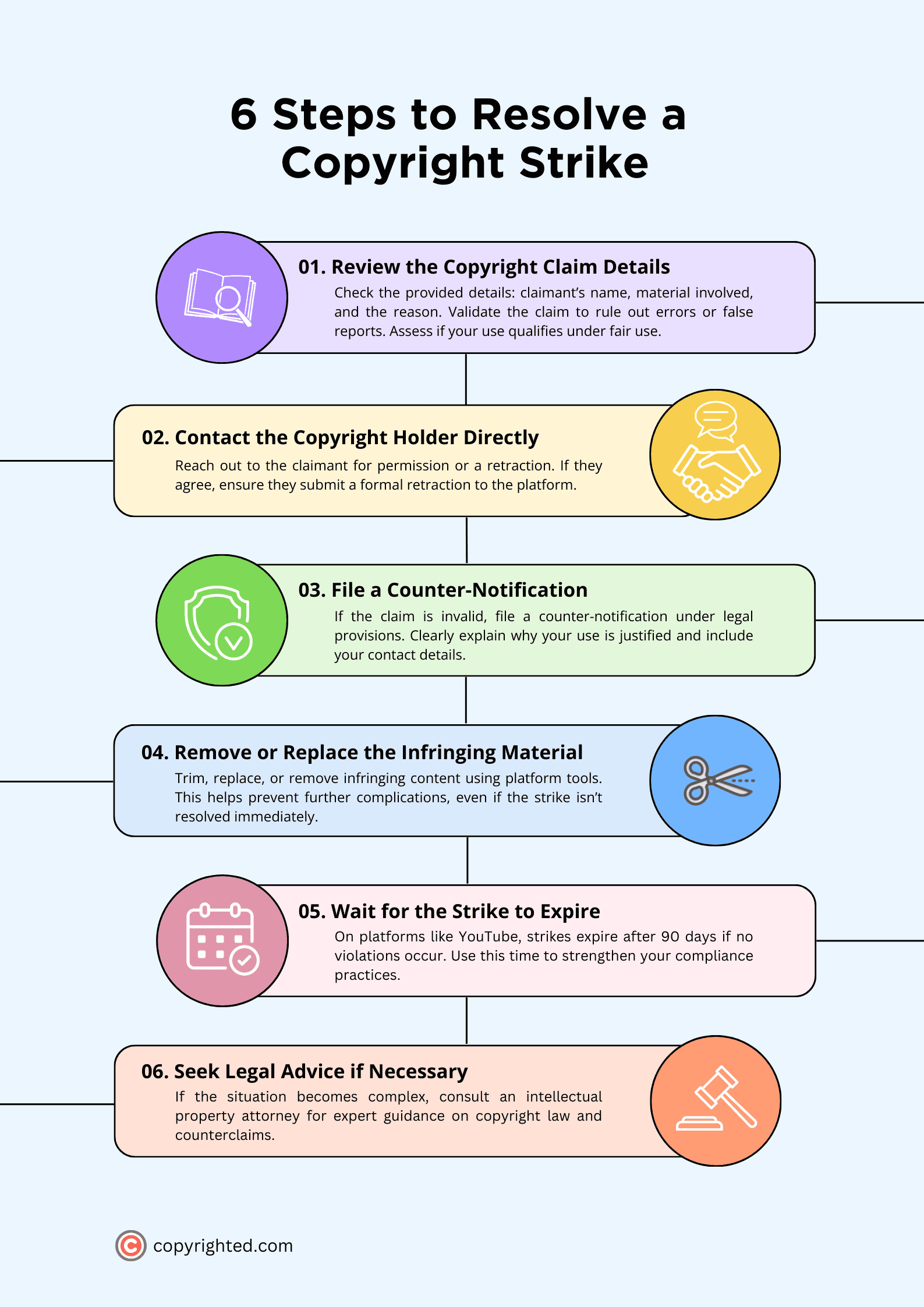Receiving a copyright strike can be both stressful and challenging, especially if you depend on platforms like YouTube for your income or creative pursuits.
A copyright strike happens when someone claims that your content uses their intellectual property without proper authorization. This can result in penalties such as video removal, account suspension, or even legal consequences.
This article explains how to address a copyright strike, understand the related laws, and avoid future conflicts.
If you’re a creator dealing with an unexpected claim or aiming to protect your work, knowing how to handle a copyright strike is key to safeguarding your rights and keeping your content accessible.
Let’s break down the process into simple, clear steps to help you take action confidently.
- Copyright strikes occur when unauthorized use of copyrighted material violates intellectual property laws or platform policies.
- You can resolve copyright strikes if you communicate with the copyright owner, submit a counter notification, or remove problematic content from the uploader’s channel.
- Preventing future strikes requires using licensed or royalty-free materials, adhering to fair use guidelines, and creating original content.
Table of Contents
Why Do Copyright Strikes Happen?
Copyright strikes happen when your content uses protected material without proper authorization or fails to comply with copyright laws. Below are some of the most common reasons for copyright strikes.
If you’re wondering what a copyright strike is, it’s a formal warning or penalty issued by a platform when it determines that your content violates copyright rules, often resulting in content takedowns, limited features, or even account suspension.
Unauthorized Use of Copyrighted Material
Using someone else’s work, like music, video clips, or images, without permission is a leading cause of copyright strikes. Copyright law grants exclusive rights to the original creator, including reproduction and public performance, according to 17 U.S. Code § 106.
If you use copyrighted material without approval, the copyright owner can file a claim.
Use of Content Without Permission or License
Even if you give credit to the original creator, simply acknowledging them does not grant you the right to use their content.
To legally use copyrighted material, you often need a proper license or written permission from the copyright holder. For instance, content from stock image websites is often provided under specific licensing terms that must be followed.
Misunderstanding of Fair Use
Fair use under 17 U.S. Code § 107 allows limited use of copyrighted material without permission for purposes like commentary, criticism, education, or parody.
Many creators mistakenly believe that changing or shortening copyrighted content automatically qualifies as fair use. Courts evaluate factors like the purpose, nature, amount used, and the effect on the original work’s market value.
What Happens if You Get a Copyright Strike?
Receiving a copyright strike can lead to several consequences, varying by platform. While one strike might not result in immediate account termination, multiple strikes or unresolved claims can have serious repercussions.
Here’s what you might face:
Restricted Features
Platforms often impose temporary restrictions after a copyright strike.
In a YouTube copyright strike, for example, you may lose access to live streaming or the ability to upload a longer YouTube video. These restrictions usually last until the strike is resolved or expires, typically within 90 days, depending on platform policies.
Account Suspension or Termination
Repeated strikes can result in the channel’s suspension or permanent deletion. YouTube’s copyright policies enforce a “three-strike” rule, where three active strikes typically result in the removal of your account, along with all your videos and data.
Impact on Revenue
A copyright strike on YouTube can disrupt income for monetized accounts. Platforms may temporarily disable monetization or redirect ad revenue from the affected content to the copyright owner.
Reduced Visibility and Reach
Copyright strikes can harm your account’s reputation and visibility.
Algorithms may deprioritize your content, lowering its ranking in search results and recommendations. This reduced visibility can decrease audience engagement and growth over time.
Legal Risks
In some cases, copyright holders may pursue legal action. Under 17 U.S. Code § 501, copyright infringement can lead to lawsuits, fines, or other legal consequences. Although most disputes don’t escalate to this level, ignoring claims can increase the risk.
How to Remove a Copyright Strike?
If you’ve received a copyright strike, you can take steps to resolve it and remove the strike from your account. Here’s how to address the issue:

1. Review the Copyright Claim Details
Start by checking the claim information provided by the platform. This usually includes the claimant’s full name, the specific material involved, and the reason for the claim.
Confirm the claim’s validity, as some may result from automated mistakes or false reports. Then, check if the material is indeed copyrighted or if it qualifies for exceptions like fair use.
2. Contact the Copyright Holder Directly
If the claim appears valid, but you want to resolve it cooperatively, consider reaching out to the copyright owner.
Ask for permission to use the material or make a copyright removal request. If the copyright holder agrees to retract the claim, request that they submit a formal retraction to the platform.
3. File a Counter-Notification
If you believe the claim is invalid or your use falls under fair use or other legal exceptions, you can file a counter-notification under 17 U.S. Code § 512.
Explain clearly why you believe the claim is incorrect.
Provide your contact details along with a statement, made under penalty of perjury, affirming that your use does not infringe copyright. Then, submit your counter-notification through the platform’s designated process.
Take note that filing a counter-notification can escalate the matter, as the claimant may pursue legal action if they disagree with your claim.
4. Remove or Replace the Infringing Material
If the strike is due to specific content, you can address it by removing or editing the problematic material. Use platform tools like YouTube’s Editor to trim out infringing sections or replace copyrighted audio.
While removing the content doesn’t instantly resolve the strike, it prevents further issues.
5. Wait for the Strike to Expire
On platforms like YouTube, strikes usually expire after 90 days if no further violations occur. While this removes the immediate penalty, it’s important to remain compliant to avoid future strikes.
6. Seek Legal Advice if Necessary
If the matter becomes complex or involves potential legal disputes, consulting an intellectual property attorney can help. They can provide guidance on copyright law and assist with counterclaims or negotiations.
For creators experiencing wrongful claims, understanding how to deal with fake copyright strike situations can also be critical, especially when the strike stems from bad actors or mistaken algorithmic detection.
How to Prevent Future Copyright Strikes?
Preventing copyright strikes requires a proactive approach to ensure your content aligns with copyright laws and platform policies. Below are some effective strategies to avoid copyright issues:
- Use Royalty-Free or Licensed Content: Choose content from royalty-free platforms or purchase the appropriate licenses for music, images, and videos. Explore resources like Creative Commons for materials that are safe to use under specified licenses.
- Understand Fair Use Guidelines: Familiarize yourself with fair use principles and use copyrighted material only for purposes like commentary, criticism, education, or parody.
- Create Original Content: The best way to avoid copyright strikes is by creating entirely original work, including music, visuals, and scripts.
- Credit Does Not Replace Permission: Giving credit to the original creator does not grant permission to use their work. Always obtain explicit permission or secure the required licenses for copyrighted content.
- Leverage Platform Tools for Copyright-Free Content: Take advantage of platform-provided libraries with copyright-safe music, images, or clips. For instance, YouTube’s Audio Library offers free music and sound effects for creators.
- Monitor Content Before Uploading: Use tools like YouTube’s “Checks” feature to identify copyright issues before publishing your content. Review every element of your content to ensure compliance with copyright laws and platform rules.
- Understand Platform Policies: Learn the copyright enforcement policies of the platforms you use to avoid accidental violations.
- Educate Your Team or Collaborators: If you work with others, ensure they understand copyright guidelines and best practices. Mistakes by collaborators can result in copyright strikes on your account.
- Use Public Domain Content: Public domain materials, such as works with expired copyrights or those explicitly released into the public domain, are free to use. Incorporating public domain content ensures you won’t face copyright claims.
Frequently Asked Questions
What is the difference between a copyright strike and a copyright claim?
A copyright strike is a penalty imposed for copyright infringement, which can restrict account features or lead to termination, while a copyright claim generally involves content disputes where ad revenue is redirected, but no penalties are applied.
How do you know if you have a copyright strike?
Platforms notify you through your account dashboard or email, outlining details like the affected content, the claimant, and potential consequences.
Can you appeal a copyright strike?
Yes, you can file a counter-notification under applicable copyright laws if you believe the strike is invalid, provided you have a lawful basis such as fair use.
Can you remove a copyright strike without contacting the copyright owner?
Yes, you can file a counter-notification to dispute the strike or address the issue by removing or editing the infringing content, but contacting the copyright owner may expedite resolution.
How long does it take to resolve a copyright strike?
Resolution times vary as strikes typically expire after 90 days if no further violations occur, but disputes can take longer based on the platform’s review process or claimant response.


